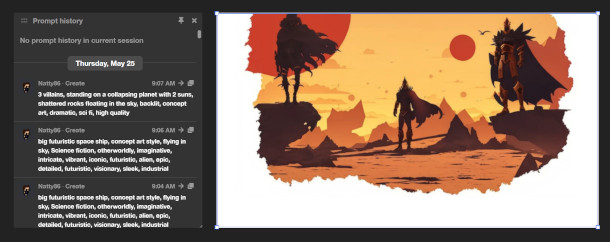Magma adds new ‘ethically responsible’ AI art tools
Collaborative browser-based art platform Magma has launched its AI Assistant, a new suite of generative AI-based tools, including text-to-image generation, inpainting and outpainting.
Magma describes the toolset, which is currently in beta, as “ethically responsible AI”, tagging the parts of an image created with AI, and storing a complete history of the text prompts used.
The AI Assistant is currently based on the contentious Stable Diffusion 2.1 AI model, an issue that Magma addressed in an email conversation with CG Channel summarised later in this story.
A collaborative browser-based platform for illustration and concept design
Launched in 2020, and originally called Magma Studio, Magma enables artists to collaborate online on a shared virtual canvas, creating images using a workflow familiar from offline tools.
Its toolset includes a range of brushes, modifiers, layer transformation and selection tools, and filters.
The platform also includes built-in feedback and communication tools, including video calls, and integrates with third-party project tracking tools like Jira.
It now has close to a million active users per month, including professionals working in game development, film and animation, particularly for concept development.
Experimental new AI Assistant adds generative AI tools to Magma
To that, Magma’s new AI Assistant – currently in public beta – adds a range of generative AI features.
As well as generating entire images from text prompts, the toolset supports inpainting to replace part of an existing image with AI-generated variants, and outpainting to extend backgrounds.

Magma stores a history of text prompts used to create the AI elements of users’ images.
An ‘ethically responsible’ approach to AI?
Magma describes the toolset as providing “ethically responsible AI”, as set out in its online AI art manifesto.
The site blocks the use of individual artists’ names in prompts, unless they have given explicit permission for users to do so, and automatically tags AI-generated content.
Although other tools developers have announced plans to tag AI-generated art – Adobe says that it intends to do so in its Firefly toolset – Magma’s approach is more granular.
In a Magma project, the specific layer created using generative AI is permanently tagged as ‘AI’, and the site stores a complete history of the text prompts used to generate the image.
The approach is intended to enable artists to establish creative ownership of of images partly generated by AI, in the light of the US Copyright Office’s recent policy statement that art works created purely from text prompts are not copyrightable.
Tagging currently applies only within Magma: the firm describes the addition of tags to the metadata of images downloaded from the site as a “top priority”.
Currently based on Stable Diffusion, but intended as a ‘proving ground’ for future models
In its initial implementation, Magma’s AI Assistant is based on the open-source Stable Diffusion 2.1 AI model.
The model is controversial in the concept art community for being trained on images scraped from the internet without their creators’ consent, issues summarised in our story on AI cloaking technology Glaze.
In an email conversation, Magma told CG Channel that “we understand [the] concerns, and agree that regardless of the power they offer, unethically trained models pose a real issue to human value.”
The firm described the AI Assistant as a “proving ground” for generative AI within the platform, and said that it “will continue to explore ethically trained models as they develop”.
Asked why it did not delay the launch until such ethically trained models became available, Magma told us: “Regardless of how strong the opposition to AI is, generative AI is here to stay in one fashion or another.”
“With this in mind, we believe that instead of taking a back seat approach and seeing how things play out, [a better solution is to discover] as quickly as possible which aspects of generative AI … are most valuable to artists while [enabling them to remain] in control of design.”
The firm also said that it was “exploring many possibilities” for users to monetise the use of their images in training future AI tools, including payments for artists who opt in to let their name be used in text prompts, and enabling users to train and publish their own custom AI models.
Price and system requirements
Magma’s AI Assistant is currently available in public beta.
It should work in any current web browser, including mobile browsers, although Magma recommends using the platform on a tablet or laptop rather than a smartphone.
Free accounts support up to five users in a single shared artspace; Professional accounts cost $25/editor/month or $250/editor/year, and support unlimited artists. See a feature comparison here.
Read more about Magma’s new AI Assistant in the online documentation
(Includes instructions on how to access the public beta)
